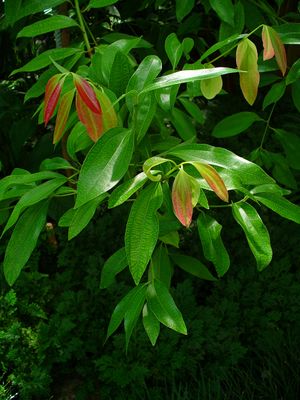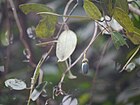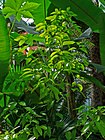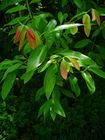Note: This is a project under development. The articles on this wiki are just being initiated and broadly incomplete. You can Help creating new pages.
Difference between revisions of "Cinnamomum verum - Darusita"
m (Prabhakar moved page Darusita (Cinnamomum verum) to Cinnamomum verum - Darusita) |
|||
| (17 intermediate revisions by 3 users not shown) | |||
| Line 1: | Line 1: | ||
[[File:Cinnamomum verum 002.JPG|thumb|right|''Darusita'', '' Dalchini'', ''Cinnamomum verum'']] | [[File:Cinnamomum verum 002.JPG|thumb|right|''Darusita'', '' Dalchini'', ''Cinnamomum verum'']] | ||
| + | '''Darusita''' is a small evergreen tree 10–15 meters tall. It is native to Sri Lanka and South India. The bark is widely used as a spice due to its distinct odour. In India it is also known as "Daalchini". | ||
| + | ==Uses== | ||
| + | {{Uses|Diabetes}}, {{Uses|Cholesterol}}, {{Uses|Cold}}, {{Uses|Common cold}}, {{Uses|Skin eruptions}}, {{Uses|Flu}}, {{Uses|Pimples}}, {{Uses|Headaches}}. | ||
| + | ==Parts Used== | ||
| + | {{Parts Used|Leaves}}, {{Parts Used|Bark}}. | ||
| − | + | ==Chemical Composition== | |
| + | The presence of a wide range of essential oils, such as trans-cinnamaldehyde, cinnamyl acetate, eugenol, L-borneol<ref name="chemical composition"/> | ||
| + | ==Common names== | ||
| + | {{Common names|kn= ದಾಲ್ಚಿನಿ Dalchini, ಕನ್ ಕುಟ್ಲು Kan kutlu,|ml=Carua, Elavangam|sa=Darusita, tvak|ta=Cannalavangapattai, Ilavangam|te=Daalchinni chakke, Lavangamu|hi=Dalcini, Darucini|en=Cinnamon|mr=Dalchini}}<ref name="Common names"/> | ||
| − | == | + | ==Properties== |
| + | Reference: Dravya - Substance, Rasa - Taste, Guna - Qualities, Veerya - Potency, Vipaka - Post-digesion effect, Karma - Pharmacological activity, Prabhava - Therepeutics. | ||
| + | ===Dravya=== | ||
| − | + | ===Rasa=== | |
| + | Tikta (Bitter), Katu (Pungent), Madhura (Sweet) | ||
| + | ===Guna=== | ||
| + | Laghu (Light), Ruksha (Dry), Tikshna (Sharp) | ||
| + | ===Veerya=== | ||
| + | Ushna (Hot) | ||
| + | ===Vipaka=== | ||
| + | Katu (Pungent) | ||
| + | ===Karma=== | ||
| + | Vata, Kapha | ||
| + | ===Prabhava=== | ||
| − | + | ==Habit== | |
| + | {{Habit|Herb}} | ||
| − | == | + | ==Identification== |
| + | ===Leaf=== | ||
| + | {{Leaf|Simple||Foliage Color is Light Green, Dark Green, Pink and Foliage Texture is Medium and Foliage Sheen is Glossy}}<ref name="Leaf"/> | ||
| − | + | ===Flower=== | |
| − | + | {{Flower|Unisexual|2-4cm long|White, Light Yellow|1|Flower Interest is Insignificant and these are the Fragrant Flowers}} | |
| − | |||
| − | == | + | ===Fruit=== |
| + | {{Fruit|Rounded|Black|Fruit is edible|Fruites are fragment|single}} | ||
| − | + | ===Other features=== | |
| + | ==List of Ayurvedic medicine in which the herb is used== | ||
| + | |||
| + | ==Where to get the saplings== | ||
| + | ==Mode of Propagation== | ||
| + | {{Propagation|Seeds}}, {{Propagation|Cuttings}}. | ||
| + | |||
| + | ==How to plant/cultivate== | ||
| + | Cinnamon can be found at elevations up to 2,000 metres, but for commercial harvesting does best at low altitudes below 500 metres<ref name="How to plant/cultivate"/> | ||
| + | |||
| + | ==Commonly seen growing in areas== | ||
| + | {{Commonly seen|Ocean islands}}, {{Commonly seen|Seychelles}}, {{Commonly seen|Lowland tropical forests}}. | ||
| + | |||
| + | ==Photo Gallery== | ||
| + | <gallery class="left" caption="" widths="140px" heights="140px"> | ||
| + | |||
| + | |||
| + | Cinnamomum verum (6674347847).jpg | ||
| + | |||
| + | |||
| + | Cinnamomum verum (6674351813).jpg | ||
| + | |||
| + | |||
| + | Cinnamomum verum (6674358785).jpg | ||
| + | |||
| + | |||
| + | Cinnamomum verum (8902536802).jpg | ||
| + | |||
| + | |||
| + | Cinnamomum verum - Murshidabad 2014-11-29 0200.JPG | ||
| + | |||
| + | |||
| + | Cinnamomum verum 001.JPG | ||
| + | |||
| + | |||
| + | Cinnamomum verum 002.JPG | ||
| + | |||
| + | |||
| + | Cinnamomum verum 003.JPG | ||
| + | |||
| + | </gallery> | ||
| + | |||
| + | ==References== | ||
| + | |||
| + | <references> | ||
| + | <ref name="chemical composition">[https://www.hindawi.com/journals/ecam/2014/642942/ Chemical Constituents]</ref> | ||
| + | |||
| + | <ref name="Leaf">[http://www.learn2grow.com/plants/cinnamomum-verum/ Characteristics]</ref> | ||
| + | |||
| + | <ref name="How to plant/cultivate">[https://www.pfaf.org/USER/Plant.aspx?LatinName=Cinnamomum+verum Cultivation details]</ref> | ||
| + | <ref name="Common names">[https://sites.google.com/site/indiannamesofplants/via-names/kannada/kan-kutlu-kan-kutlu Common names]</ref> | ||
| + | </references> | ||
| + | |||
| + | ==External Links== | ||
| + | * [https://davesgarden.com/guides/pf/go/70370/#b Cinnamomum verum on daves garden] | ||
| + | * [http://www.medicalhealthguide.com/herb/cinnamon.htm Cinnamomum verum on medical health guide] | ||
| + | * [https://www.herbal-supplement-resource.com/cinnamon-herb.html Cinnamon – Side Effects and Benefits] | ||
| + | * [https://www.herbco.com/t-Medicinal-Uses-of-Cinnamon.aspx Medicinal Uses of Cinnamon Reviewed] | ||
[[Category:Herbs]] | [[Category:Herbs]] | ||
| + | [[Category:Lauraceae]] | ||
Latest revision as of 09:13, 18 June 2020
Darusita is a small evergreen tree 10–15 meters tall. It is native to Sri Lanka and South India. The bark is widely used as a spice due to its distinct odour. In India it is also known as "Daalchini".
Contents
- 1 Uses
- 2 Parts Used
- 3 Chemical Composition
- 4 Common names
- 5 Properties
- 6 Habit
- 7 Identification
- 8 List of Ayurvedic medicine in which the herb is used
- 9 Where to get the saplings
- 10 Mode of Propagation
- 11 How to plant/cultivate
- 12 Commonly seen growing in areas
- 13 Photo Gallery
- 14 References
- 15 External Links
Uses
Diabetes, Cholesterol, Cold, Common cold, Skin eruptions, Flu, Pimples, Headaches.
Parts Used
Chemical Composition
The presence of a wide range of essential oils, such as trans-cinnamaldehyde, cinnamyl acetate, eugenol, L-borneol[1]
Common names
| Language | Common name |
|---|---|
| Kannada | ದಾಲ್ಚಿನಿ Dalchini, ಕನ್ ಕುಟ್ಲು Kan kutlu, |
| Hindi | Dalcini, Darucini |
| Malayalam | Carua, Elavangam |
| Tamil | Cannalavangapattai, Ilavangam |
| Telugu | Daalchinni chakke, Lavangamu |
| Marathi | Dalchini |
| Gujarathi | NA |
| Punjabi | NA |
| Kashmiri | NA |
| Sanskrit | Darusita, tvak |
| English | Cinnamon |
Properties
Reference: Dravya - Substance, Rasa - Taste, Guna - Qualities, Veerya - Potency, Vipaka - Post-digesion effect, Karma - Pharmacological activity, Prabhava - Therepeutics.
Dravya
Rasa
Tikta (Bitter), Katu (Pungent), Madhura (Sweet)
Guna
Laghu (Light), Ruksha (Dry), Tikshna (Sharp)
Veerya
Ushna (Hot)
Vipaka
Katu (Pungent)
Karma
Vata, Kapha
Prabhava
Habit
Identification
Leaf
| Kind | Shape | Feature |
|---|---|---|
| Simple | Foliage Color is Light Green, Dark Green, Pink and Foliage Texture is Medium and Foliage Sheen is Glossy |
Flower
| Type | Size | Color and composition | Stamen | More information |
|---|---|---|---|---|
| Unisexual | 2-4cm long | White, Light Yellow | 1 | Flower Interest is Insignificant and these are the Fragrant Flowers |
Fruit
| Type | Size | Mass | Appearance | Seeds | More information |
|---|---|---|---|---|---|
| Rounded | Black | Fruit is edible | Fruites are fragment | single | {{{6}}} |
Other features
List of Ayurvedic medicine in which the herb is used
Where to get the saplings
Mode of Propagation
How to plant/cultivate
Cinnamon can be found at elevations up to 2,000 metres, but for commercial harvesting does best at low altitudes below 500 metres[4]
Commonly seen growing in areas
Ocean islands, Seychelles, Lowland tropical forests.
Photo Gallery
References
External Links
- Ayurvedic Herbs known to be helpful to treat Diabetes
- Ayurvedic Herbs known to be helpful to treat Cholesterol
- Ayurvedic Herbs known to be helpful to treat Cold
- Ayurvedic Herbs known to be helpful to treat Common cold
- Ayurvedic Herbs known to be helpful to treat Skin eruptions
- Ayurvedic Herbs known to be helpful to treat Flu
- Ayurvedic Herbs known to be helpful to treat Pimples
- Ayurvedic Herbs known to be helpful to treat Headaches
- Herbs with Leaves used in medicine
- Herbs with Bark used in medicine
- Herbs with common name in Kannada
- Herbs with common name in Hindi
- Herbs with common name in Malayalam
- Herbs with common name in Tamil
- Herbs with common name in Telugu
- Herbs with common name in Marathi
- Herbs with common name in Sanskrit
- Herbs with common name in English
- Habit - Herb
- Index of Plants which can be propagated by Seeds
- Index of Plants which can be propagated by Cuttings
- Herbs that are commonly seen in the region of Ocean islands
- Herbs that are commonly seen in the region of Seychelles
- Herbs that are commonly seen in the region of Lowland tropical forests
- Herbs
- Lauraceae








